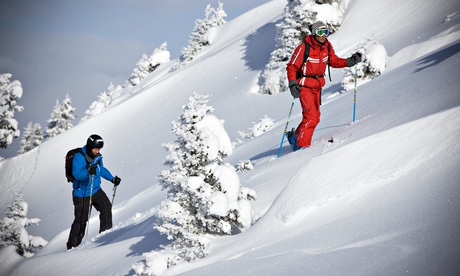
A few miles from the crowded pistes of Morzine, in the French Alps, even snowboarders can find peace and solitude. This is thanks to a technique that was developed in the mid-1990s but is only now becoming popular beyond the circle of a few enthusiasts.
Splitboards are designed to help snowboarders reach higher peaks, and are so called because they split the board down the middle to make two wide skis, which can be used with skins for climbing slopes. At the top, the "skis" can be reconnected to form a standard, descent-ready board.
A growing awareness of splitboarding mean riders are able to access terrain that was previously only the domain of skiers (who had the upper hand when it came to accessing higher ground), or could be reached only by arduous hiking or expensive helicopters.
Twice a year, Morzine-based chalet company Mountain Mavericks runs a splitboarding expedition called the Backcountry Project, where riders get to spend four days exploring the vast backcountry of the Portes du Soleil, Europe's largest ski domain. The company is run by a husband-and-wife team, Olly and Emma Lambourne, who moved to the Alps with their young family six years ago.
Last year Olly, who has 15 years of snowboarding under his belt, decided to diversify from chalet management into splitboarding tours, having seen more and more clients wanting to try the emerging sport. So I sign up to test it out myself.
"The project was set up for those who find resort boundaries confining and aren't afraid to earn their turns," Olly says. In the company of exceptional mountain guides, boarders get an ideal opportunity to improve their backcountry awareness and summit those virgin snowfields. But they do have to sweat a little in the process.
The level of expertise required means splitboarders tend to be a hardy bunch. James Heinz, a professional sailor and yacht coach who was part of my group, says: "I've always envied the buzz my ski-touring friends get, but I've never wanted to abandon my snowboard. The Backcountry Project was a perfect solution."
Traditional off-piste, guideless boarding can often involve an amount of macho foolhardiness. Here, it's more about a unique mountain experience, and safety is paramount.
"We work with guides such as Guillaume and Olaf, who were raised on the mountains and have the qualifications and experience to lead a group in high areas," says Olly. "They have a knowledge of situations that can arise, an understanding of our area."
For the first two days boarders usually ride Morzine's hidden tree runs: this helps brush away any cobwebs, and allows Guillaume to monitor the group's ability and provide thorough briefings on transceiver use, probes and avalanche awareness.
On day three, things get serious, with a hike up Pointe d'Angolon, past the Vallée de la Manche, heading for an overnight at a remote lodge. Skinning up Col de la Golèse can take at least two-and-a-half hours, but the goal, Refuge de Bostan, is cosy and welcoming. Emmanuel, the softly spoken manager, has only solar power and a single log burner at his disposal, but manages to offer guests a hearty three-course Savoyarde dinner, complete with homemade aperitifs.
The following morning brings another two-hour ascent, with spectacular views of Mont Blanc, to Tête de Bostan. For riders, this is the high point of the trip, in both senses of the word. From the summit, one by one, boarders can carve a personal line down an unscathed mountainside, where it's not uncommon to find wildlife, such as a herd of leaping Alpine ibex, watching your every move. You wanted to snowboard in untouched wilderness. That's what you'll get.
• The trip was provided by Mountain Mavericks, whose next Backcountry Project trip starts on 15 March and costs £950pp, including six nights' accommodation and four days' guiding, but not flights. EasyJet, Jet2, Flybe and Thomson fly to Geneva from several UK airports. Transfers to Morzine with Skiidy Gonzales cost €30 each way. Six days' splitboard rental costs €295. Participation in the project requires good fitness and intermediate off-piste ski/snowboard experience

